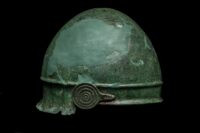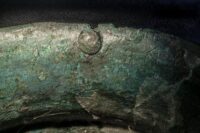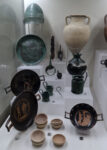 Archaeologists have found an Etruscan inscription inside a 2,400-year-old bronze helmet that was discovered 91 years ago in a tomb in Vulci, on the Tyrrhenian coast of Umbria in central Italy. It is an exceptionally rare find. Of all the known Etruscan helmets found in funerary contexts from the 6th through 3rd centuries B.C., there are no more than a dozen with inscriptions, and this one has been hidden in the plainest of sight: on public display since 1935 at the National Etruscan Museum of the Villa Giulia in Rome.
Archaeologists have found an Etruscan inscription inside a 2,400-year-old bronze helmet that was discovered 91 years ago in a tomb in Vulci, on the Tyrrhenian coast of Umbria in central Italy. It is an exceptionally rare find. Of all the known Etruscan helmets found in funerary contexts from the 6th through 3rd centuries B.C., there are no more than a dozen with inscriptions, and this one has been hidden in the plainest of sight: on public display since 1935 at the National Etruscan Museum of the Villa Giulia in Rome.
Discovered in Tomb LV of the small necropolis of the Osteria just north of Vulci in 1930, the bronze helmet can be dated from its typology and in comparison to the other grave goods in the richly furnished tomb to the middle of the 4th century B.C. This was a contentious time in the Italian peninsula, with local peoples vying on the battlefield for territorial control and against invaders like the Celts who sacked Rome in 390 B.C.
In 2019, the helmet was re-examined to assess its conservation needs and fully recorded as part of an effort to digitize the absolutely massive holdings of the Villa Giulia (plan at least three whole days if you want to see everything, like bare minimum, seriously). The new study revealed for the first time the existence of an inscription on the interior of the helmet.
 The epigraph was inscribed inside the neck roll of the helmet after its manufacture. It is a complete sequence of seven letters reading HARN STE. (The space is there because there’s a rivet between the N and the S, but Harnste is a single word.) While it is impossible to say with certainty that this was a personal name inscribed by the helmet’s owner like your mom Sharpied your name on the waistband of your undies when you went to camp, only the owner would be familiar enough with the inside of his helmet to put a name on it.
The epigraph was inscribed inside the neck roll of the helmet after its manufacture. It is a complete sequence of seven letters reading HARN STE. (The space is there because there’s a rivet between the N and the S, but Harnste is a single word.) While it is impossible to say with certainty that this was a personal name inscribed by the helmet’s owner like your mom Sharpied your name on the waistband of your undies when you went to camp, only the owner would be familiar enough with the inside of his helmet to put a name on it.
Vulci was famous in its time for its bronze work and the helmet was assumed to be of local manufacture when it was first discovered, but more recent scholarship and closer examination of the helmet points towards it having been made in Perugia where the vast majority of helmets of this type, midway between the early Etruscan Negau type and the Celtic Montefortino type, have been found. The name “Harnste” also provides a linguistic link to Perugia, as the name of an Etruscan woman “Harnustia” was found in an epigraph near the Hypogeum of the Volumni in a suburb of Perugia.
 The Villa Giulia museum has temporarily put the helmet in a new display case so visitors can examine it up close. After the Epiphany, it will be returned to its usual location, on display with other objects recovered from Tomb LV.
The Villa Giulia museum has temporarily put the helmet in a new display case so visitors can examine it up close. After the Epiphany, it will be returned to its usual location, on display with other objects recovered from Tomb LV.
Here’s a 360-degree video of it in its temporary display location.
What came first the Etruscans or the Greeks?
Bowl one nine an early Valentine
There were people before the Greek colonists arrived in Italy, but it is probably a matter of debate if those really do count as “Etruscan”. However, according to Pliny (Sr.):
————
“Umbrorum gens antiquissima Italiae existimatur, ut quos Ombrios a Graecis putent dictos, quod in inundatione terrarum imbribus superfuissent. Trecenta eorum oppida Tusci debellasse reperiuntur…” (ὄμβρος = heavy rain, thunderstorm) / “The Umbrian people are considered the oldest in Italy, and they are believed to have been called ‘Ombrios’ by the Greeks, because they went through the inundation of the land because of the rain. The Tusci (Etruscans) conquered three hundred of their cities.”
————
From right to left (!), HARNSTE / 𐌇𐌀𐌓𐌍𐌔𐌕𐌄, may refer to the “Arnates” mentioned by Pliny, from the ‘Arna’ township in Umbria (Ἄρνα), ‘Civitella d’Arna’ in Perugia.
Hence, the owner of the helmet belonged to those Arnates (note: there is also an ‘Arna’ in Greece):
:hattip:
———-
“Civitella d’Arna boasts of Umbrian origins, but it was the Etruscans who were chiefly responsible for its development in the 4th century BC. The Ancient name Arna in the Etruscan language meant “river current” and probably referred to its position between the rivers Tiber and Arno.”
———-
PS: No idea, how the ANSA found “Aharnam”, but they probably meant the same:
“The helmet, forged in bronze in Perugia in the middle of the fourth century BC for a mercenary and later found in the tomb of an Etruscan warrior, has now been found to carry the inscription “”harn ste” inside, a likely reference to the ancient city of Aharnam, today’s Civitella d’Arna, cited by Roman historian Livy as the encampment of a praetor before the Battle of Sentinus during he Third Samnite War in 295 BC.”
Don’t take it seriously, just to entertain you:)
𐲀 = A (Hungarian, damaged)
𐲢 = R (Hungarian)
𐲀 = A (Hungarian)
𐲚 = NY (Hungarian)
Arany = Golden, Gold
?
𐲓 = K
?k = ? OR ? ?k = ?
𐲙 = N (Hungarian)
𐲑 = Í (Hungarian)
𐲠 = P (Hungarian)
Níp = ~Nép = Nation, Folk
All together: Golden ? Nation
Don’t take it seriously, just to entertain you:)
𐲀 = A (Hungarian, damaged)
𐲢 = R (Hungarian)
𐲀 = A (Hungarian)
𐲚 = NY (Hungarian)
Arany = Golden, Gold
?
𐲓 = K
?k = ? OR ? ?k = ?
𐲙 = N (Hungarian)
𐲑 = Í (Hungarian)
𐲠 = P (Hungarian)
Níp = ~Nép = Nation, Folk
All together: Golden ? Nation